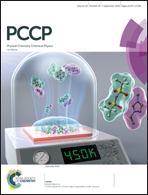Achieving ultrahigh carrier mobilities and opening the band gap in two-dimensional Si2BN†
Abstract
Recently, a two-dimensional (2D) Si2BN monolayer material made of silicon, boron and nitrogen, was theoretically predicated and has attracted interest in the scientific community. Due to its 2D planar nature with high formation energy, Si2BN monolayers can be flexible and strong like graphene and also exhibit captivating properties like those of other 2D materials. Motivated by this fascinating graphene-like monolayer of Si2BN, we have investigated its structural and electronic properties based on first-principles calculations. The electronic band structure of pure Si2BN shows metallic behaviour. We have discovered that the band gap of Si2BN monolayer can be tuned to 102 meV by applying external electric fields and mechanical strain. The band gap opening occurs at 5% strain, where the bond angles between the nearest neighbours become nearly equal. The band gap opening occurs at a small external electric field of 0.4 V Å−1. More interestingly, at room temperature, the electron mobility of Si2BN is 4.73 × 105 cm2 V−1 s−1, which is much larger than that of graphene, while the hole mobility is 1.11 × 105 cm2 V−1 s−1, slightly smaller than the electron mobility. The ultrahigh carrier mobility of Si2BN may lead to many novel applications in high-performance electronic and optoelectronic devices. These theoretical results suggest that the Si2BN monolayer exhibits multiple effects that may significantly enhance the performance of Si2BN based electronic devices.



 Please wait while we load your content...
Please wait while we load your content...